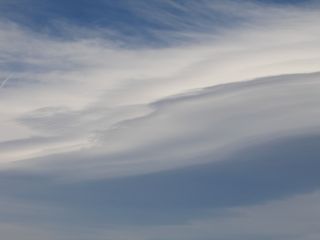I keep returning to the Mono Pass area for hiking. I’ve been exploring the region from all directions, having hiked, over the years, Mt Dana and Gibbs and the Granite Divide in between, Parker Pass and Mt. Lewis, and the Mono Pass Trail itself. I decide to tackle the south-west region of the area, the Kuna Crest and it’s lakes.
 Smoke from the fires on the east side still linger, but we notice a very peculiar cloud to our west. Being an amateur weather buff, I have Shad take photos of it from all angles. It’s a stratiform cloud, shaped by the winds shearing off the mountains. It’s shaped like a series of solid eights, in a wave formation, and has several different textures within.
Smoke from the fires on the east side still linger, but we notice a very peculiar cloud to our west. Being an amateur weather buff, I have Shad take photos of it from all angles. It’s a stratiform cloud, shaped by the winds shearing off the mountains. It’s shaped like a series of solid eights, in a wave formation, and has several different textures within.
Making it even more peculiar is the smoke clouds drifting around it. I know there is a phenomena called the Sierra Wave and I vow to consult the guidebook when I get home.
From the shoulder of Mammoth Peak, we ascend into the basin containing Kuna Lake. The crest hugs Kuna Lake tight in its basin and the gem-blue water reflects the sky above. The wind is a forcible presence here and I can see why we have stratiform clouds above. I hold onto Shad when a wave of wind roars into the basin that bends the tops of the trees. Then oddly enough it’s silent again. I joke about nor’easters, being from New England, but Shad, being from the Midwest, experienced tornadoes, so this is pretty tame stuff to him.
Next comes Bingaman Lake, smaller and not nestled so tightly in the cliffs. We find multiple animal tracks on its muddied shores: marmot, coyote and something unidentifiable. We follow its outlet down, hoping over monkey flower patches near the stream, and then veer east to explore Spillway Lake. No swimming today; it’s cloudy and breezy and we haven’t worked up enough of a sweat to make the cold water enticing.
From Spillway Lake we make our way back via the Parker Pass Trail. The strange cloud still looms overhead, its massive stillness unusual.
 On my drive up to Tuolumne this afternoon, I witnessed the most spectacular Sierra Wave cloud display that I have yet beheld. Regular readers of my blog will be familiar with my addiction to clouds, and seeing a Sierra Wave is akin to a birder viewing a condor in the wild. Shad, my partner, said he had a full view of the wave across the mountain range when he drove home from Catheys Valley and I chided him for not having a camera. For the fascinating story behind this magnificent cloud, see my article.
On my drive up to Tuolumne this afternoon, I witnessed the most spectacular Sierra Wave cloud display that I have yet beheld. Regular readers of my blog will be familiar with my addiction to clouds, and seeing a Sierra Wave is akin to a birder viewing a condor in the wild. Shad, my partner, said he had a full view of the wave across the mountain range when he drove home from Catheys Valley and I chided him for not having a camera. For the fascinating story behind this magnificent cloud, see my article. 
